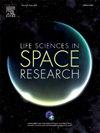微生物在太空中的恢复力:生物膜、风险和空间探索的策略
IF 2.8
3区 生物学
Q2 ASTRONOMY & ASTROPHYSICS
引用次数: 0
摘要
生物膜是一个微生物群落,可以在任何表面形成,提出了几个挑战和重大的医学问题。它们的形成不仅局限于地球,而且在空间站也被观察到,被称为太空生物膜。这是一个主要的问题,因为某些生物膜可能导致高风险的损害机组人员的健康,而其他生物膜有能力腐蚀航天器和设备,导致仪器故障,这可能危及任务。此外,由于微重力的影响,生物膜在太空中的形成和表现方式与在地球上的不同。微重力和其他空间条件加强了航天器表面微生物生物膜的形成、致病性和抗生素耐药性。本文综述了航天器生物膜及其对设备、乘员健康和航天器的影响。这篇综述还讨论了几种已知在航天器上形成生物膜的关键微生物物种。它强调了抗菌涂层、生物膜干扰物和多种检测方法如何在长期任务中保护航天飞机的完整性和机组人员的健康。它还强调了在太空飞行任务中减轻和消除生物膜的破坏和控制策略。然而,由于数据有限、成本高和在地球上复制空间微重力,研究空间生物膜仍然需要大量的研究来克服现有的挑战。要在太空中有效地管理生物膜,特别是要解决微重力下生物膜的形成问题,调查抗菌效果,并评估其对宇航员健康的影响,以执行可持续的长期任务,需要创新战略。本文章由计算机程序翻译,如有差异,请以英文原文为准。
Microbial resilience in space: Biofilms, risks and strategies for space exploration
Biofilms are a community of microorganisms that can form on any surface, posing several challenges and significant medical issues. Their formation is not just limited to Earth but has also been observed in space stations and are termed as space biofilms. This is a major concern as certain biofilms can lead to high-risk compromising crew’s health, while others have the capacity to corrode spacecraft and equipment, leading to instrument malfunction, which can jeopardize the mission. Additionally, the way biofilms form and behave in space is different from how they do on Earth due to microgravity. Microgravity and other space conditions intensify microbial biofilm formation, pathogenicity, and antibiotic resistance on spacecraft surfaces. This review examines spacecraft biofilms and their effects on equipment, crew health, and spacecraft. The review also discusses several key microbial species that are known to form biofilms on spacecraft. It highlights how antimicrobial coatings, biofilm disruptors, and multiple detection methods could protect space shuttle integrity and crew health during long missions. It also highlights the disruption and control strategies to mitigate and eradicate biofilms in spaceflight missions. However, significant research is still required to overcome existing challenges of studying space biofilms due to limited data, high cost and replicating space microgravity on earth. Innovative strategies are required for effective biofilm management in space, especially to address biofilm formation under microgravity, investigate antimicrobial efficacy, and to assess its health impacts on astronauts for sustainable long-term missions.
求助全文
通过发布文献求助,成功后即可免费获取论文全文。
去求助
来源期刊

Life Sciences in Space Research
Agricultural and Biological Sciences-Agricultural and Biological Sciences (miscellaneous)
CiteScore
5.30
自引率
8.00%
发文量
69
期刊介绍:
Life Sciences in Space Research publishes high quality original research and review articles in areas previously covered by the Life Sciences section of COSPAR''s other society journal Advances in Space Research.
Life Sciences in Space Research features an editorial team of top scientists in the space radiation field and guarantees a fast turnaround time from submission to editorial decision.
 求助内容:
求助内容: 应助结果提醒方式:
应助结果提醒方式:


